Beijing Belt and Road Forum Launches
‘Project of the Century’
by William Jones
May 2017
View full size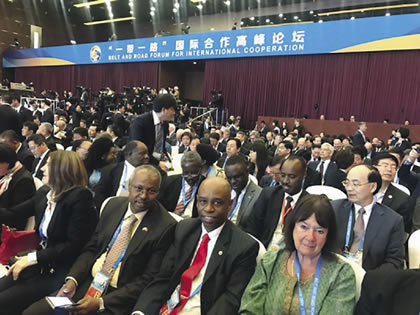
Schiller Institute
Helga Zepp-LaRouche (lower right) and other participants on May 14, 2017, at the opening session of the Belt and Road Forum for International Cooperation. |
May 16, 2017—The Belt and Road Forum, held in Beijing on May 14-15, brought together 29 heads of state and heads of government and over 1,500 delegates, including many heads of think-tanks dealing with the Belt and Road Initiative (BRI). Most prominent among these was Schiller Institute President Helga Zepp-LaRouche, who is considered by many Chinese scholars as the inspiration behind the project. During the conference, Mrs. Zepp-LaRouche received extensive media coverage and was well received by all the delegates. The Forum was a clear consolidation by the Chinese government of the overwhelming support for the Belt and Road Initiative by over 100 governments and international institutions.
President Xi Jinping opened the conference with a sweeping philosophical vision of what the world might look like if we reject the pettiness and intrigues of traditional geopolitics. “Over 2,000 years ago, our ancestors, trekking across vast steppes and deserts, opened the transcontinental passage connecting Asia, Europe, and Africa, known today as the Silk Road,” President Xi said. “Our ancestors, navigating rough seas, created sea routes linking the East with the West, namely, the maritime Silk Road. These ancient silk routes opened windows of friendly engagement among nations, adding a splendid chapter to the history of human progress. Spanning thousands of miles and years, the ancient silk routes embody the spirit of peace and cooperation, openness and inclusiveness, mutual learning, and mutual benefit. The Silk Road spirit has become a great heritage of human civilization.”
Xi went through the origins of the ancient Silk Road with the dispatch by the Han Emperor of Zhang Qian, who opened the road to the West, launching a new era of collaboration between East and West, an exchange of goods and produce as well as an exchange of ideas and culture. China exported its four great inventions to the West (the compass, gunpowder, papermaking, and printing), and received from the West the astronomy, medicine, and calendar of the Arabs. “History is our best teacher,” Xi said. “The glory of the ancient silk routes shows that geographical distance is not insurmountable. If we take the first courageous step towards each other, we can embark on a path leading to friendship, shared development, peace, harmony, and a better future.” Such is the paradigm he wished to build in this modern era as an alternative to the wars and conflicts that have marked the rule of “geopolitics.” “From the historical perspective, humankind has reached an age of great progress, great transformation, and profound changes,” Xi continued. “In this increasingly multi-polar, economically globalized, digitized, and culturally diversified world, the trend toward peace and development becomes stronger, and reform and innovation are gaining momentum. Never have we seen such close interdependence among countries as today, such fervent desire of people for a better life, and never have we had so many means to prevail over difficulties.”
View full size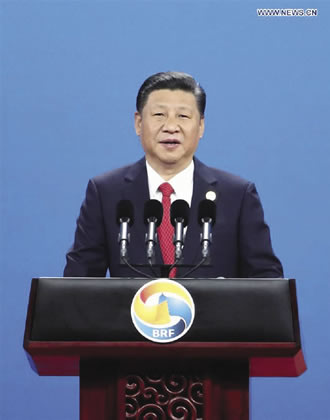
China’s President Xi Jinping delivers the keynote address at the Belt and Road Forum, May 14, 2017. |
“In terms of reality, we find ourselves in a world fraught with challenges. Global growth requires new drivers, development needs to be more inclusive and balanced, and the gap between the rich and the poor needs to be narrowed. Hotspots in some regions are causing instability, and terrorism is rampant. Deficit in peace, development, and governance poses a daunting challenge to mankind. This is the issue that has always been on my mind,” Xi said.
He then outlined some of the achievements of the first five years of the endeavor, noting how the Belt and Road dovetails with the individual development programs of the countries along the way. While he noted that the Belt and Road were a Chinese proposal, he undelined that the initiative itself is owned by all who participate and share in its benefits.
Xi then laid out five characteristics of the Belt and Road. First, it must become a road of peace. “We should foster a new type of international relations featuring win-win cooperation,” Xi said, “and we should forge partnerships of dialogue with no confrontation and of friendship rather than alliance. All countries should respect each other’s sovereignty, dignity, and territorial integrity, each other’s development paths and social systems, and each other’s core interests and major concerns,” he said.
The Master Key
Second, it must become a road of prosperity. “Development holds the master key to solving all problems,” Xi said. “In pursuing the Belt and Road Initiative, we should focus on the fundamental issue of development, release the growth potential of various countries and achieve economic integration and interconnected development and deliver benefits to all.”
Third, it must be a road of opening up. “We should build an open platform of cooperation and uphold and grow an open world economy,” he said. “We should jointly create an environment that will facilitate opening up and development, establish a fair, equitable and transparent system of international trade and investment rules, and boost the orderly flow of production factors, efficient resources allocation, and full market integration. We welcome efforts made by other countries to grow open economies based on their national conditions, participate in global governance and provide public goods. Together, we can build a broad community of shared interests.”
And fourth, it must become a road of innovation. “We should spur the full integration of science and technology into industries and finance, improve the environment for innovation, and pool resources for innovation,” Xi said. “We should create space and build workshops for young people of various countries to cultivate entrepreneurship in this age of the internet and help realize their dreams.” In this regard, China, in the coming five years, will offer 2,500 short-term research visits to China for young foreign scientists, train 5,000 foreign scientists, engineers, and managers, and set up 50 joint laboratories.
View full size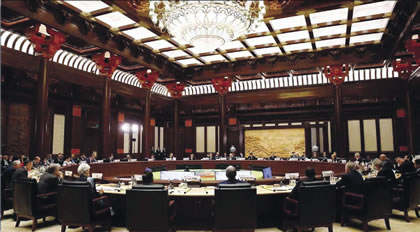
Xinhua
Leaders’ Round Table Summit of the Belt and Road Forum, chaired by China President Xi Jing on May 15, 2017, the day after the opening session. |
Fifth, it must become a road connecting different civilizations. “In pursuing the Belt and Road Initiative,” Xi said, “we should ensure that when it comes to different civilizations, exchange will replace estrangement, mutual learning will replace clashes, and coexistence will replace a sense of superiority. This will boost mutual understanding, mutual respect, and mutual trust among different countries.”
To underline the Chinese commitment to the success of the initiative, Xi announced that China would commit an additional 100 billion RMB (about $14.5 billion) to the Silk Road Fund, and that the China Development Bank and the China Export-Import Bank would set up special lending schemes respectively worth 250 billion RMB and 130 billion RMB for Belt and Road projects on infrastructure, industrial capacity, and financing.
Xi announced that China will also provide assistance worth RMB 60 billion to developing countries and international organizations participating in the Belt and Road Initiative to launch more projects to improve people’s well-being. It will also provide emergency food aid worth RMB 2 billion to developing countries along the Belt and Road and make an additional contribution of US$1 billion to the Assistance Fund for South-South Cooperation.
China will also set up many new mechanisms to support the Belt and Road, Xi said, including a liaison office for the Forum’s follow-up activities, along with the Research Center for Belt and Road Financial and Economic Development, the Facilitating Center for Building the Belt and Road, the Multilateral Development Financial Cooperation Center in cooperation with multilateral development banks, and an IMF-China Capacity Building Center.
President Putin’s Historic Goal
View full size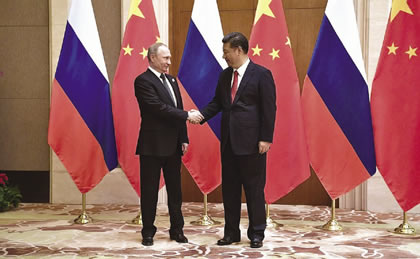
President of Russia Vladimir Putin, left, and President of China Xi Jinping. |
The other speakers at the plenary following the Chinese President underlined their whole-hearted supported for President Xi’s initiative. The first to follow the Chinese President, in a very important symbolism, was Russian President Vladimir Putin, the closest collaborator with President Xi among world leaders on the Belt and Road project. In his speech, Putin reiterated the complementarity of the Belt and Road project and Putin’s own proposal for a Eurasian Economic Union (EAEU). “I believe,” Putin said, “that by adding together the potential of all the integration formats like the EAEU, the OBOR (Belt and Road), the SCO (Shanghai Cooperation Organization) and the ASEAN (Association of Southeast Asian Nations), we can build the foundation for a larger Eurasian partnership. This is the approach that, we believe, should be applied to the agenda proposed today by the Peoples Republic of China. We would welcome the involvement of our European colleagues, which would make it truly concordant, balanced and all-encompassing, and will allow us to realise a unique opportunity to create a common cooperation framework from the Atlantic to the Pacific for the first time in history.”
One after the other, government leaders and leaders of the international organizations spoke on behalf of the Belt and Road Initiative. New mechanisms were set up for financing and a Memorandum of Understanding was signed the multilateral development banks affirming their support for the Belt and Road Initiative.
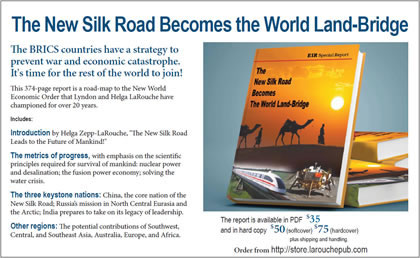 Click here for more information, and to purchase this book |
In a press conference following the meeting, President Xi said that China had signed Belt and Road cooperation agreements with 68 countries. At the Leaders’ Roundtable at the conclusion of the conference, there were leaders of 30 countries as well as representatives of the UN, the World Bank and the IMF. They had reached, Xi said, a “broad consensus” in their exchange of view and had issued a joint communique.
Also attending the Forum was U.S delegation headed by Matthew Pottinger, head of the East Asia Bureau of the National Security Council and a Special Assistant to President Trump. Pottinger expressed support for U.S. companies becoming engaged in the Belt and Road Initiative and said that the U.S would set up an American Belt and Road Working Group, which would be a partnership between the U.S Embassy and U.S. companies and would serve, Pottinger said, “as a node for collaboration in the area.”
